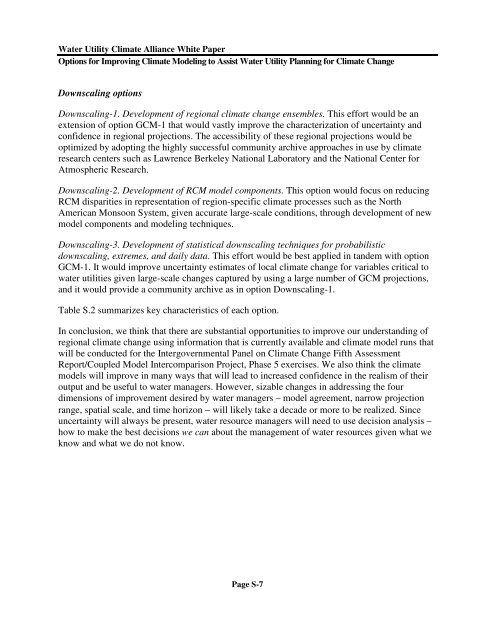Options for Improving Climate Modeling to Assist Water Utility ...
Options for Improving Climate Modeling to Assist Water Utility ...
Options for Improving Climate Modeling to Assist Water Utility ...
Create successful ePaper yourself
Turn your PDF publications into a flip-book with our unique Google optimized e-Paper software.
<strong>Water</strong> <strong>Utility</strong> <strong>Climate</strong> Alliance White Paper<br />
<strong>Options</strong> <strong>for</strong> <strong>Improving</strong> <strong>Climate</strong> <strong>Modeling</strong> <strong>to</strong> <strong>Assist</strong> <strong>Water</strong> <strong>Utility</strong> Planning <strong>for</strong> <strong>Climate</strong> Change<br />
Downscaling options<br />
Downscaling-1. Development of regional climate change ensembles. This ef<strong>for</strong>t would be an<br />
extension of option GCM-1 that would vastly improve the characterization of uncertainty and<br />
confidence in regional projections. The accessibility of these regional projections would be<br />
optimized by adopting the highly successful community archive approaches in use by climate<br />
research centers such as Lawrence Berkeley National Labora<strong>to</strong>ry and the National Center <strong>for</strong><br />
Atmospheric Research.<br />
Downscaling-2. Development of RCM model components. This option would focus on reducing<br />
RCM disparities in representation of region-specific climate processes such as the North<br />
American Monsoon System, given accurate large-scale conditions, through development of new<br />
model components and modeling techniques.<br />
Downscaling-3. Development of statistical downscaling techniques <strong>for</strong> probabilistic<br />
downscaling, extremes, and daily data. This ef<strong>for</strong>t would be best applied in tandem with option<br />
GCM-1. It would improve uncertainty estimates of local climate change <strong>for</strong> variables critical <strong>to</strong><br />
water utilities given large-scale changes captured by using a large number of GCM projections,<br />
and it would provide a community archive as in option Downscaling-1.<br />
Table S.2 summarizes key characteristics of each option.<br />
In conclusion, we think that there are substantial opportunities <strong>to</strong> improve our understanding of<br />
regional climate change using in<strong>for</strong>mation that is currently available and climate model runs that<br />
will be conducted <strong>for</strong> the Intergovernmental Panel on <strong>Climate</strong> Change Fifth Assessment<br />
Report/Coupled Model Intercomparison Project, Phase 5 exercises. We also think the climate<br />
models will improve in many ways that will lead <strong>to</strong> increased confidence in the realism of their<br />
output and be useful <strong>to</strong> water managers. However, sizable changes in addressing the four<br />
dimensions of improvement desired by water managers – model agreement, narrow projection<br />
range, spatial scale, and time horizon − will likely take a decade or more <strong>to</strong> be realized. Since<br />
uncertainty will always be present, water resource managers will need <strong>to</strong> use decision analysis –<br />
how <strong>to</strong> make the best decisions we can about the management of water resources given what we<br />
know and what we do not know.<br />
Page S-7

















